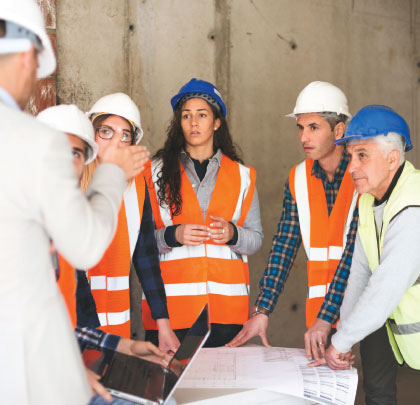Building a top-notch safety culture doesn’t happen overnight. Getting buy-in from employees requires a top-down approach starting with the executive officers. “Safety First” can’t just be lip service delivered to workers from upper management, it must be put into practice by building a strong safety culture within your organization. Your commitment to safety should be one of the core principles of your company’s culture.
Here are six ways you can improve and build upon your construction company’s safety culture:
1. MAKE SAFETY YOUR TOP PRIORITY
Jobsite safety should be placed above everything else: costs, productivity, timelines, etc. Your employees are your number one asset, proving to them that their safety is your top concern on every project instills confidence and builds trust.
Putting safety first can help reduce costs and improve productivity on the jobsite. Accidents lead to cost overruns and project delays. Improving safety means fewer days lost due to accidents and injuries. A strong safety record can also help reduce insurance costs.
2. TRAINING, TRAINING, TRAINING
Properly training your workers is the easiest way to help improve your company’s safety culture. It shows your workers that you are committed to keeping them safe and healthy.
Training shouldn’t be a one-off event. Safety training should be a continuous and ongoing effort to help reinforce best practices. Ongoing training helps your workers better retain what they’ve been taught and it keeps safety top of mind.
3. GET WORKERS INVOLVED, INVESTED
Put together a safety committee that includes employees from all levels of your business. They should be involved in reviewing and updating your company’s safety program, crafting jobsite-specific safety plans during the preconstruction phase of each project and helping identify potential hazards and safety concerns.
Create a corrective action plan with input from employees. Make sure all workers are aware of the plan to ensure it is properly executed and enforced.
Assemble an accident response team for each jobsite made up of a few employees who have some basic first aid training. They should know what steps to take in the event an injury occurs to mitigate any existing hazards and administer first aid to injured workers.
Workers involved in the process of building and improving your safety culture will feel invested and are more likely to take safety seriously. They are also more likely to communicate their concerns if they feel their input is valued.
4. HOLD ALL ACCOUNTABLE
Everyone who steps foot on the jobsite is responsible for safety, not just your safety managers and those in charge. Workers should know that unsafe practices not only put themselves in danger but also those around them. Make sure safety rules are clearly defined and explained to everyone on the site and that the consequences for failing to follow the rules will be strictly enforced.
You should also empower employees to speak up and report unsafe conditions, near misses, or coworkers failing to follow safety protocols. Everyone on the site should have the power to order a work stoppage to address and correct any safety issues.
5. REWARD GOOD, PUNISH BAD
Use incentives to reward workers for adhering to safe working practices, attending safety meetings, wearing personal protective equipment (PPE), reporting near misses, making suggestions to improve safety, and reporting unsafe conditions or hazards.
Be careful about relying on an incentive program that rewards workers for going so many days without an accident or injury, as it could lead to underreporting. Encouraging and rewarding workers for their proactive approach to safety will result in fewer accidents and injuries.
6. SITE INSPECTIONS, SAFETY MEETINGS
Jobsites should be inspected before and after each workday to address any safety concerns such as tools left lying around or damaged equipment. Jobsites should also be inspected throughout the day to identify any potential hazards and monitor workers to make sure they are working safely.
Hold a brief safety meeting before work begins each day to go over what tasks are scheduled along with the safety procedures to follow. Be sure to address any concerns or issues and acknowledge the good practices observed from the prior day.
CONCLUSION
Good or bad, your company already has a safety culture, but there’s always room for improvement. Having a rock-solid safety culture means making the commitment to put safety first. Instituting programs and procedures that reinforce that commitment takes time, employee engagement, and making adjustments in order to improve.
For More Information:
Content provided by ConstructConnect, a leading provider of construction information and technology solutions in North America and is committed to transforming the way the construction industry does business by providing its customers the tools, information, and connections needed to drive their success. ConstructConnect brings the construction industry together with the most complete, accurate, and actionable construction data and tools to drive success in national, regional, and local markets. For more information, visit www.constructconnect.com.
_________________________________________________________________________
Modern Contractor Solutions, June 2018
Did you enjoy this article?
Subscribe to the FREE Digital Edition of Modern Contractor Solutions magazine.



